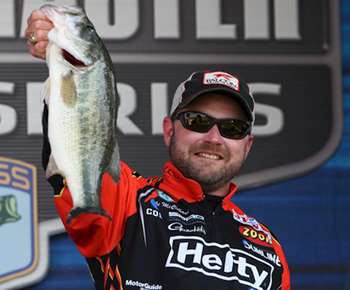
Elite Series pro Mike McClelland has etched his name into bass fishing's history through his prowess as an offshore specialist. Much of his success has been garnered by dragging a jig around the depths; however, he's no slouch when it comes to throwing a Carolina rig either.
The Arkansas pro maintains that the key lies in knowing when to use one technique over the other. "You really almost have to let the fish tell you when is the right time to throw a Carolina rig versus a jig," he explains. "The one thing that I've found over the last five years is that a football head jig, with today's color selection, weights and quality hook, is always going to be a great starting point for me."
McClelland explains that the Carolina rig, up until only a few years ago, was the "go-to" choice if you wanted a slow, deep-water presentation. "We just didn't have many options other than a Carolina Rig," he says. "Over the past few years, lure manufactures have really stepped up and devoted a lot of attention to the deep jig."
Despite the innovations in quality components and colors, McClelland maintains that there are still times when bass prefer the Carolina rig. "The Carolina rig allows you to present a different bait that's going to have a motion in the water," he says. "Also, it usually allows you to throw a bigger bait than you could get away with on a jig. When I'm Carolina rigging, I'm typically going to be throwing a 10-inch Zoom 'Ol Monster worm or a full-size Brush Hog to target bigger fish."
Many times, McClelland suggests, the action of a Carolina rig can be the trigger. "If bass are really lethargic and forcing you to really soak a bait, you want as little movement as possible. That's when I reach for the Carolina rig," he says. "When you get into a situation where the fish are a lot more active, the jig gives you a lot more options. You can just do a lot more with a jig — whether you stroke it, or drag it, or whatever."
With conventional wisdom dictating that bigger baits equal bigger bites, McClelland says that he'll upsize his jig's trailer. "Especially during the postspawn period, because they're generally looking for a bigger meal," he says of the upsized trailer, but points out that one of the biggest keys to success with either bait is knowing the independent strengths of each.
"A lot of times I'll use the Carolina rig as my search bait, because it so easy to cover water with it. Once I dial into a specific piece of cover or structure, I'll pick up the jig so that I can make pinpoint accurate casts." However, McClelland says that when bass are scattered away from cover, the Carolina rig is tough to beat. "This is really big during the postspawn," he says.
"The [Carolina] rig's greatest strength is that you can cover so much water with it. There's hardly a better bait to use if bass are scattered out across the bottom." Regardless of each technique's specific uses, if forced to make a choice between the two baits, it's an easy decision for McClelland to make. "I would have to pick the jig," he says.
"At the end of the day, it's all about confidence. While I might have both tied on at all times, I'm always going to reach for the jig first."
(Provided by Z3 Media)
